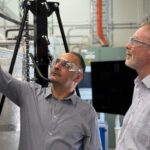Curtin University researchers have taken large strides towards revolutionising drug delivery for asthmatics and people with lung diseases, potentially saving thousands of lives and millions of dollars.
Associate Professor Ben Mullins from the School of Public Health and lead researcher on the project, said respiratory illnesses were the most common causes of death in people over 65 years.
“Chronic Obstructive Pulmonary Disease (COPD) and pneumonia are two of the top five killers of the elderly, with COPD claiming one patient every 10 seconds,” Associate Professor Mullins said.
“Asthma affects approximately 15 per cent of the Australian population and $358 million is spent on asthma medication alone per year, yet more than 95 per cent of it is wasted.
“This is because it is not delivered to the appropriate target area of the airway and the main reason for this is that models to accurately predict the capture of particles on moving surfaces in unsteady flow (such as human airways), do not exist yet.
“In response to this, we developed the most advanced and physiologically realistic lung model to simulate airflow, which will revolutionise aerosol drug delivery (such as Ventolin inhalers) and also assess exposure to airborne pollutants.
“This research is the first of its kind and allows us to get better information on what is happening at highly localised regions in the lung. This will, in turn, allow us to better target drug delivery to where it is needed most.
“This will be highly beneficial to asthmatics, people with COPD, and patients with lung disease, as well as all groups exposed to environmental pollutants in the atmosphere.
This is part of a larger project which aims not only to design better aerosol drug delivery systems, but to develop tools to predict surgical outcomes on a patient-by-patient basis to better inform surgeons prior to invasive lung surgery,” Associate Professor Mullins said.
Read the paper, titled ‘The influence of moving walls on respiratory aerosol deposition modelling’ that has been published in the Journal of Aerosol Science.
The research was conducted in collaboration with the Telethon Institute for Child Health Research and funded by the Asthma Foundation WA.


